In 2006 the thatched house in Lymington on the Hampshire coast which had been the home of Ken Russell (b 1927) for 30 years burned down. All of the director’s original film scripts, including Women in Love, The Devils and Tommy, were destroyed. So was the bulk of the music collection which inspired him to make his groundbreaking films about composers in the 1960s. There is, however, one part of the Russell archive which has survived, for the simple reason that for 50 years it had never once been in his possession.
In the 1950s, after giving up on a career as a dancer, Russell freelanced as a photographer. Submitting work to the Pictorial Press agency, his photographs appeared in publications such as Illustrated Magazine and Picture Post. Eventually, scraping together the funds to make three amateur films, he landed a job with the BBC’s Monitor programme and forgot all about his photographs. So did everyone else. They remained unexhumed even when Pictorial Press was bought by TopFoto 30 years ago. It was only in 2005 that the bulk of the archive was discovered in a box. When Alan Smith of TopFoto took them down to Lymington, Smith’s refusal to leave them in Russell’s care prevented their incineration.
The still pictures bear the quirky hallmarks of the moving pictures which would follow, and also bear witness to a postwar London pockmarked by bombsites, where teddy girls, models, children on the Portobello Road and the Household Cavalry all caught Russell's roving eye. As the collection went on show in a retrospective at Proud Chelsea, the original enfant terrible talked to theartsdesk.
JASPER REES: Why did you take up photography?
KEN RUSSELL: I always wanted to get into films and it was a closed shop when I was trying. I wrote to all the studios and I got the feeling unless you knew someone who was a cameraman or a clapper boy, why should they give you a job? It’s not like today when you can just press a red button and prove to someone you’ve either got it or you haven’t. It was too expensive. I took up photography as the next best thing after trying other jobs. Rather strange ones perhaps.
Before that, in a long-forgotten phase of your career, you were a dancer. What did you dance in?
Annie Get Your Gun. I was a dancer in the Norsk ballet, a dancer in the London Theatre Ballet, a dancer in the British Dance Theatre.
How good were you?
Terrible. The only reason I took up dancing was I was invalided out of the Merchant Navy and my mother got bored of me sitting at home and said, "Ken, go in your father’s business or go in the Air Force. Just get away from under my feet." So I went in the Air Force as I didn’t want to try boots and shoes on people for the rest of my life. In the Air Force I asked permission at training camp to run the music circle. I got interested in classical music and most camps did have a music group where the guy in charge played records. Most camps had a big selection. The education officer said, "Someone else has just applied, a sailor, Bert Woodfield." I contacted this guy and said, "I hear you’re running the music circle, do you mind if I join you? I’m sure we’ve got different tastes." He said OK. We ran the music circle in the camp cinema which was a big hall, and a projection room which was soundproof.
One day I saw this burly man jump in the air, turn round twice, glide across the floor and do a grand jeté, followed by a pirouette. I said, "What’s that?" He said, "It’s ballet." I said, "I like that." Before I knew it we were both dancing to Swan Lake. He said, "What are you doing after you’re demobbed?" I said, "I don’t know, nothing. I’ve been trying to get into the film business. It’s impossible." He said, "You should take up dancing, you’ve got possibility." So I said, "Yeah, but in Southampton they don’t have any." He said, "No, you can come to London." I said, "I have no home in London." He said, "You can rent a flat." I said, "Really? How do you do that?" He said, "I could look around for you where I live. It’s not far from central London. It’s called Enfield." Enfield was about 25 miles, I found. Anyway he got me a room which I shared with three Irish labourers. I didn’t know you could get a private room.
To cut a long story, I joined the Hampstead Ballet Club, which he belonged to - he was a very good amateur dancer. I soon saw that I was going to learn nothing because they were all clerks and secretaries. I thought, I want to do this full-time. I discovered the International Ballet School did scholarships so I applied, got a scholarship. Stayed there five years, was always spraining ankles because I started too late, started at 21 when most people are finishing. After five years they said, "Sorry, Ken, it’s not going to happen. You’re not going to become a classic dancer." That’s when I joined Annie Get Your Gun, and I went from one company to another for a few years. Then I finally packed that in and joined the Garrick Players in Newton Poppleford and I was there till it went bankrupt. I was about 27. I stayed in the ballet till I was 25.
Once I got into films I never thought, I wonder what happened to the negatives?
Anyway, I stayed in a house with a lot of dancers, and a photographer was dating one of the girls and I happened to show him some snaps I had taken on my travels to Norway when I was in the ballet. They were just snaps. He said, "You’ve got promise. You’re looking for a job. Why don’t you take up photography? You’ve got an eye." I said, "Well, how would I do that?" He said, "I teach at Walthamstow and if you said you lived there you could join free." And so I did and studied photography, learning all about texture, form and pattern, for three years, because I saw it as a stepping stone to movies. And with the money I managed to save up, after I became a professional I did this, that and the other, and I managed to make three amateur movies. They got me into the BBC and the Monitor programme and then I never touched a camera again, and I forgot all about the pictures I’d taken.
I was under the wing – I wasn’t employed by them – of a freelance agency called Pictorial Press. They tried to flog my pictures here and there. Sometimes they succeeded, sometimes they didn’t. Then I began to take pictures for Illustrated Magazine, which was a rival to Picture Post, and I began to make a bit of money. Then I married someone I met at the art school who was studying dress design. I used to photograph her dresses and photograph her. She was very pretty. We married, settled down and started a family. I just managed to survive with the money I made from the photographs but as soon as I had done my three amateur movies I never touched a stills camera again. Once I got into films I never thought, I wonder what happened to the negatives. I just lost total interest. It’s weird. They began to surface when someone was doing an exhibition on the teddy girls. And that’s when they discovered my photographs that I’d forgotten I’d taken 50 years ago.
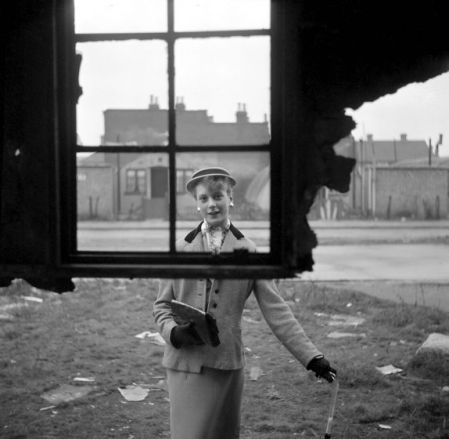
When did you hear of them cropping up again?
Someone had heard about the teddy girl pictures and did a search, and the present company that had bought up Pictorial Press was called TopFoto and that’s where they were. I didn’t think much more about it. I saw the exhibition and thought, I’d forgotten I took those. Then TopFoto said, "We’ve inherited all your old negatives." I said, "What old negatives?" And they sent me the prints and I thought, my God, did I take these? They’re not bad. Secretly I think they’re rather special. They’re a bit odd and they’re of their time. Some are a bit abstract/surreal. I’m surprised this many have survived.
How many years were you a working photographer?
Well, [the record] says from 1951 to 1957 but I don’t remember starting as early as that.
When did you go to art college?
When was the coronation? 1951.
1953.
When was the Festival of Britain? 1951. What was I doing then? I think it could have been about 1952 or 1953. But maybe I took some in 1951. I think 1957 was when I really started dedicating myself to making these amateur movies. One became quite famous: it’s called Amelia and the Angel. It won various prizes.
Watch a clip from Amelia and the Angel
The one I like seems to have vanished. I’d just been converted. I did a satirical look at Lourdes, in colour in 16mm. I wrote to Benjamin Britten because I loved his ballet The Prince of the Pagodas, which had lots of movements, very short but very pithy, I thought I could cut these sequences lasting about a minute, two minutes. This is the perfect score to pick and choose from. So I wrote to him and said, "I’ve made this film on Lourdes, can I use your Prince of the Pagodas?" And much to my amazement he wrote back and said yes, didn’t want any money or anything. So I had an amazing soundtrack. After that I was a fully blown Catholic. I did take stills. They weren’t called slide films. They had a definite name. I became friendly with Tony Evans, who ran the Catholic Film Institute. I thought it sounded grandiose and he used to review films in the Catholic Herald. I thought, well, maybe they’ll finance me. His office was in a very damp cellar in Victoria and he was penniless. But he became a friend and went to Lourdes with me and we both worked on it. I couldn’t afford an editing machine so I edited it on a projector. I showed it to MGM and they said, "I wouldn’t give you five pounds for the world rights." But having done the stills then I graduated to cine. I borrowed a cine camera. Then I showed them to the BBC and I got the job.
What stills camera did you have?
I had two. One was a 35mm Leica. One was a Rolleicord. A Rolleicord is a reflex camera. That means you have two lenses, one above the other. The top lens projects the picture onto the screen you look onto, which is the size of the shot. It’s two and a quarter by two and a quarter. It was robust. The Rolleicord was the cheap version. The Rolleiflex was more deluxe. I also had a plate camera, because I thought in fashion photography that would be good, but I kept knocking it over. That was a disaster. It was Victorian.
You knew your stuff?
I was three years at the school. You learned about texture, form and pattern, which I promptly discarded - I wasn’t into that. We had two teachers. One who was the balletomane character and the other was a rather dodgy gentleman called Mr Basil who was always fond of photographing nudes.
Nothing wrong with that.
I wasn’t very good at talking to the fashion models. I didn’t have the gift of the gab
No. Depends what you did with the nudes after. We were encouraged to do portraiture, and that’s when I met my future wife, who was very beautiful. And so three years there, we were encouraged to roam around and photograph things of interest. And that’s when I did the teddy girls. It was the first job or realisation that here was a subject that might swell and interested me personally, because they were so bizarrely dressed. My wife who was a fashion designer had a good friend called Josie Buchan who was a teddy girl, so that’s how I got to see a real-life one. She’s in a number of my pictures.
They were the first ones you were paid for?
I suppose they were.
How did you get attached to an agency?
I haven’t the faintest memory. No idea.
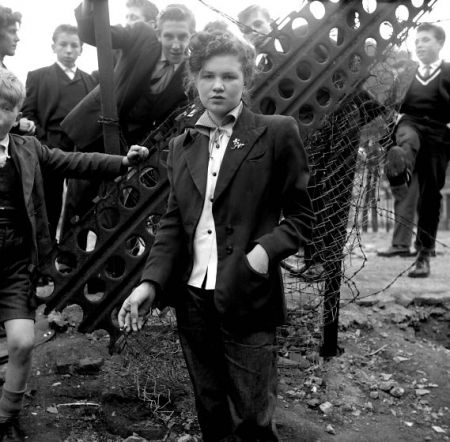
Did you give yourself assignments?
I gradually got a few assignments. I began working for Lilliput Magazine photographing pretty girls. It had short stories and how you should dress and girlie pictures. They had shorts and bikinis and stuff.
Did you enjoy it?
I didn’t mind. It was pay. It wasn’t bad pay. I can’t say I was insane about it.
I proudly printed them all and showed him and he said, 'I can’t see the fucking clothes, all you’ve got is lovely reflections of you taking the picture'
What other publications did you work for?
Photography Magazine, Illustrated Magazine, occasionally Picture Post.
Do you remember a sense of thrill that your work was being used?
Not particularly, because it was a slow process. I tried first of all - because I had my future wife to photograph - to get into Vogue and Harper's. They were quite interested. There was one magazine I got into, I think it was Elle. Don’t know if it’s still going. Pretty sure it was Elle. The photographs I took as incentives and to show my style were rather bizarre. They only wanted straight fashion against a white backdrop, which didn’t interest me and I wasn’t terribly good at it. I wasn’t very good at talking to the fashion models. I didn’t have the gift of the gab. So I sort of struggled.
I did work for a couple of advertising agencies. I did quite a lot of work with Spangles. I don’t know if they’re still going. I did my wife and her girlfriend hiking in shorts and one’s turning to the other, it’s a back view, and the caption is, "Got the map? Got the Spangles?" Then I worked for an ad agency called Arpad Alpha. I just tootled around and he’d give me odd jobs. He said, "I need men’s fashions in Burton's. Go and take shots from the street." So I went. I proudly printed them all and showed him and he said, "I can’t see the fucking clothes, all you’ve got is lovely reflections of you taking the picture." I did a bit of this, that and the other. During that, on my honeymoon, my wife and I went to Haworth, the Brontë village, and stayed at the Red Bull where the brother used to get drunk and stoned. There are a couple of my wife in one of her Victorian costumes as Emily Brontë. While I was up there, me and my wife did a whole series.
Don’t forget I saw more films than anyone in England, maybe in the world, by the time I was 21. I was beaten when I went to Pangbourne Nautical College. I used to break bounds to go and see Dorothy Lamour in Reading and I was caught and beaten for it, and it was well worth it. So it was inevitable, having seen so many films, that if I couldn’t get into films then in a way I should have thought of photography sooner.
I’d see a hip bath in Portobello Road and I’d buy it and I’d take pictures of the hip bath being used. People fishing in it. My favourite one is the girl underneath it walking along. Lampshades - I’d buy a big old Twenties lampshade down Portobello and I’d make it into a skirt for a woman or a hat for another woman. In a way I was making still films, I suppose, of images.
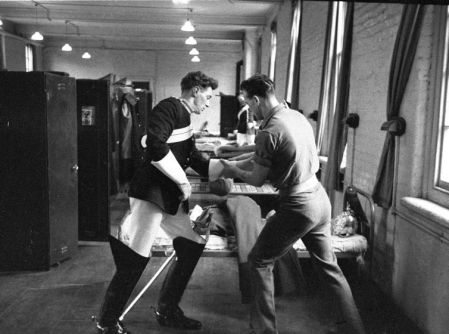
What was it about the Household Cavalry that appealed to you?
It was probably an assignment. They are amazing. I haven’t seen so many of them just relaxed and mooching about.
As you were photographing, do you remember being into it and in the moment? Was it ever just a job?
No, no, no. I wouldn’t have done it at all. I’ve never done anything I didn’t like. That’s why I didn’t go into Dad’s boot and shoe shop, whereas my brother did. It was a voyage of discovery. I did a whole set of fashions based on the Addams Family. I don’t know where they’ve gone but they were crazy monsters on top of roofs and walking along gutterings. Weird, dangerous things. I thought it was funny. I dressed up as a policeman pursuing a thief. Then I did another series, ridiculous by-laws of Hyde Park, and had my landlady holding up a big pair of bloomers. "You are not to sort rags and old clothes in Hyde Park."
There is one series where I did a children’s wedding. God, I'd be arrested for that now
How many of the ones that came off your own bat were intended for sale?
They were all intended for sale.
How many did you sell?
Twenty-five per cent. I did a wonderful photograph of the cellist Piatigorsky. It’s on a record cover someone sent me. I thought, William Walton’s new cello concerto is going to be premiered and that’s quite an event and Piatigorsky is the greatest cellist in the world. I asked permission to film it in the Festival Hall. No problem. No one else was there. Now you couldn’t move if there was an event like that. But the agency had a guy who sold the pictures and he didn’t manage to sell that to the Sunday papers. He didn’t think they’d buy it.
How did they pay?
I suppose I got five quid a picture.
Did you feel like you were making a living?
Well, I was scraping by. While I was learning ballet my dad gave me five quid a week for food, and I did get married when I was taking these photographs. I know I didn’t have a bundle of money. But I guess I scraped by.
The two men on bicycles. Did you set that up?
The bikes were off the wall of the oldest coffee bar in London, the Troubadour. I personally knew the owner. He appeared in my movies. I borrowed his decorations. I did several with those bikes. The caption at the time was "The answer to the Suez fuel crisis".
There is another of children in a flooded street.
I used to live in Portobello Road and I did eventually move to Notting Hill Gate. When I used to get back from the teaching in Walthamstow – I lived in Linton Gardens then, I always lived in the area for many years – and after going home and having a cup of tea I’d go out in the evening and just wander Portobello for several years. Children fascinated me. They lived like beggars, and I was conscious that they were poor little sods.
Did you slip them a few pennies?
No. Didn’t have a few pennies. Don’t forget I was still a pupil of the school. I can’t think that I had any money at all. I don’t know if my dad helped me out. I can’t remember. As soon as I could handle a camera I remember wandering.
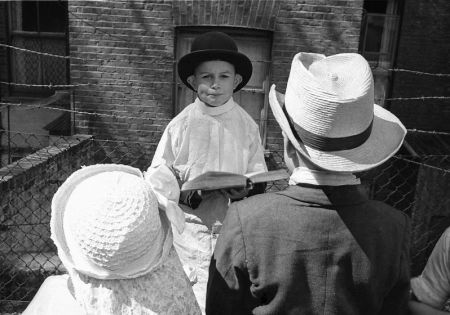
What would happen if you took pictures of children in the street now?
There is one series where I did a children’s wedding. God, I'd be arrested for that now, where I got them to dress themselves up and I must have just said, and I never even saw their parents, "Ask your mum for some funny old clothes she don’t want. Let’s imagine we’re all grown up and you two are going to get married." I don’t remember talking to any parents. I did that in a bombsite just off Portobello Road. I used bombsites a lot, especially with the teddy girls in Walthamstow. Good background. Better than a bungalow. And there were so many about. You didn’t have to look for them. Don’t forget this was the early Fifties. They hadn’t started rebuilding yet.
And there were a lot of people around.
Oh yeah, wandering around. Sitting on doorsteps. One of my favourites is three women in turbans on doorsteps.
I thought, no one’s going to give me credence for doing this
You’d go out with the Leica?
No, I often used the Rolleicord. They seemed to like having their picture taken, if in fact they noticed. They didn’t always notice.
It’s possible you couldn’t have that career now?
They don’t like being photographed now. Then they didn’t care. I did a little film recently for BAFTA. They were doing a competition called Sixty Seconds of Fame and they encouraged everyone in the land from eight-year-olds to 80-year-olds to make a movie. So I made one. I imagined it was 10 years after the event and the two announcers from South Today say, BAFTA had this competition 10 years ago to get everyone interested. And so I showed all colours, creeds, ages and sexes, either holding BAFTAs or filming. We had by law to pay them £1 and they had to sign a form saying it was OK. If I’d been doing that, I’d be broke.
Watch Sixty Seconds of Fame
When you participated in Celebrity Big Brother, as you did a few years ago, what was in it for you?
It was a challenge, and also coincidentally I did watch the programme quite a lot, and six months before I was asked to go on it I was asked to go to the Brontë festival in Haworth. I thought, that sounds fun, I’d rather like to be involved in that. So I suggested to the authorities that I make a short 10-minute film of an aspect of the event. I suddenly came up with the idea that Charlotte Brontë was a bit of a schizo in so far as she called Jane Eyre an autobiography, and in some respects it was, and so I devised a little entertainment to be shot on the lawn of the vicarage with some locals playing the roles. There was a couple of characters from Jane Eyre, and also her brothers and sisters. So I wrote a scenario, a ballet, which I mostly choreographed myself, called Charlotte Brontë Enters the Big Brother House. I had her continually called to the Diary Room. It was a challenge because my children said, "You’re mad, you can’t do it." My daughter, who is 40, hid behind the sofa and just used to peep over the top, until she saw it was all right.
Did you want to give a kick up the arse to your career?
I thought it would probably make me even less popular than I am. I thought, no one’s going to give me credence for doing this. But when it came out I couldn’t move in the street for being mobbed. I was delighted. I’m sure it was for that reason I was asked to cut the blue ribbon that opens the new Marks & Spencer in the high street. I got a bottle of Champagne. I made a speech.
Did your photography inform your film-making?
I rumbled to the value of the perfect composition. I’ve always chosen the set-up through the camera. I can take advice from the operator or the director of photography but I’ve got in my mind what I want. That’s what I always get. And I genuinely operate myself, because trying to explain to the operator what you want you may as well do it. Also it’s the closest you’re going to get to the action. If the actors know that you’ve got your beady eye on them while they’re doing it, it’s the way to do it.
Would you have been the same film-maker without it?
Who can say? It concentrated me onto composition. Some of the photographs were catch as catch can. But a lot of them are very consciously composed. But there comes a time when you automatically do it. You don’t have to think, oh, is this the right composition? You can’t do the wrong one.
Watch Peepshow, a short film made by Ken Russell in 1956


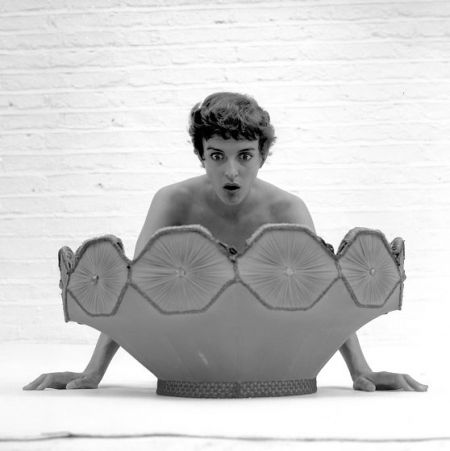













Add comment